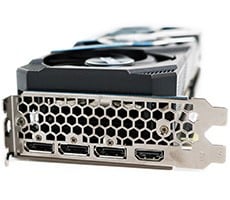NVIDIA GeForce 8800 GTX and 8800 GTS: Unified Powerhouses
For our next round of tests we took a look at Digital Video processing performance between the two competing core GPU architectures, "PureVideo" technology at work for NVIDIA and "AVIVO" driving ATI.
|
|
|
To characterize CPU utilization when playing back WMV HD content, we used the Performance Monitor built into Windows XP. Using the data provided by Windows Performance Monitor, we created a log file that sampled the percent of CPU utilization every second, while playing back the 1080p version of the "Amazing Caves" video available for download on Microsoft's WMVHD site. The CPU utilization data was then imported into Excel to create the graph below. The graph shows the CPU utilization for a GeForce 7900 GTX, a Radeon X1950 XTX, and the GeForce 8800 GTX using Windows Media Player 11, with XP patched using the DXVA updates posted on Microsoft's web site (Updates Available Here). The desktop resolution was set to 1920 x 1200 for these tests.

Average CPU Utilization (Core 2 Extreme X6800 @ 2.93GHz)
| GeForce 7900 GTX | Radeon X1950 XTX | GeForce 8800 GTX |
| 16.48% | 16.0065407% | 16.0065407% |
One of the more interesting things to ever happen in the HH labs, took place during our CPU utilization testing for this article. As you can see in the graph above, all three of the cards handled the Amazing Caves video without much of a problem. No card ever went over the 25% CPU utilization mark. With a GeForce 7900 GTX in the test system, roughly 16.5% of CPU resources were used during the playback of this HD video. With both the Radeon X1950 XTX and GeForce 8800 GTX installed though, exactly 16.0065407% of the CPU's resources were required. We factored the result out to seven decimal places to show just how wild this result was. With 86 samples recorded during the video playback for each GPU, the results averaged out to the exact same value. Any mathematicians in the audience? What are the odds of that happening again?
|
|
|
Next up, we have the HQV DVD video benchmark from Silicon Optics. HQV is comprised of a sampling of SD video clips and test patterns that have been specifically designed to evaluate a variety of interlaced video signal processing tasks, including decoding, de-interlacing, motion correction, noise reduction, film cadence detection, and detail enhancement. As each clip is played, the viewer is required to "score" the image based on a predetermined set of criteria. The numbers listed below are the sum of the scores for each section. We played the HQV DVD using the latest version of Intervideo's WinDVD 7 Platinum Suite, with hardware acceleration and PureVideo extensions enabled.

NVIDIA's latest Forceware drivers give the GeForce 7900 GTX a nice boost in performance in this test, and give the GeForce 8800 series of cards a slight edge over ATI's Radeon X1950 XTX. The only differences between the GeForces and Radeon, however, were in the Noise Reduction tests, where we gave the NVIDIA-powered cards a slight advantage. In all honestly though, if HQV's scoring guidelines allowed it, we'd probably give ATI a 7.5 on the NR tests, and NVIDIA an 8. But HQV doesn't allow this. The output from either architecture is really that close.






